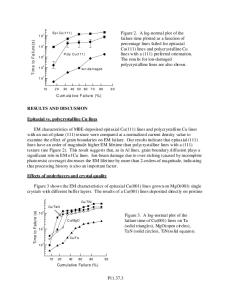Grain Boundary Migration and Grain Growth Induced by Electromigration in Copper and Aluminum Lines
- PDF / 3,025,613 Bytes
- 6 Pages / 414.72 x 648 pts Page_size
- 87 Downloads / 402 Views
INTRODUCTION Electromigration (EM) induced damages in metal interconnection lines is a serious problem in reliability of integrated circuits. Cu is considered to be the most promising alternative substitute for Al which is commonly used as interconnect material, primarily because Cu is expected to have much better EM resistance due its lower diffusivity. Indeed, the activation energy of self diffusion along grain boundaries (GB) - the process that is known to control EM rate in polycrystalline interconnect lines - is equal to 1.2 eV for Cu, whereas it is only about 0.6 eV for Al. Recent observations have demonstrated that lines made of Cu may have activation energies of EM damage in the range from 0.6 to 1.2 eV [1,2]. An explanation of these low values might be the GB migration. It is well established that mass transport during EM occurs mainly along GBs. The atom diffusion flux may cause GB migration as it was observed in the processes of low temperature homogenization (so called "diffusion-induced grain boundary migration" (DIGM) [3,4]). Although the dependence of GB diffusivity on GB migration is still open and quite controversial [5,6], we suggest that a significant decrease in EM activation energy may stem from the EM induced GB movement. The goal of our work was to reveal whether GB migration takes place during electromigration and how it is related to damage formation.
EXPERIMENTAL In order to reveal GB behavior induced by an electric current, we used thin unpassivated films which are suitable for studies in a transmission electron microscope (TEM). An Al film of 160 nm thickness and a Cu film of 100 nm thickness were fabricated by e-beam evaporation onto an oxidized Si substrate at 200 0 C and 350 0 C for Al and Cu respectively, in a vacuum of 5.10-7 Torr. Before the metal deposition a thin carbon film of 20 nm thick was deposited onto 283
Mat. Res. Soc. Symp. Proc. Vol. 391 01995 Materials Research Society
the SiO 2 /Si substrate to prevent strong interaction of the metal film with the substrate in the following EM experiment. This allows us to remove the metal line from the substrate after the EM experiment and to study the film in the TEM. The films were annealed at 4000 C during 0.5 hour and patterned using photolithography to form four-probe geometry specimens with a line width of 10 pm and a length of 100 pm. The direct electrical current with a density of 107 A/cm 2 was applied during 10 hours, in vacuum at 200 0 C and 3500C for Al and Cu, respectively. The temperature of the substrate was controlled by a thin film thermometer. The temperature of the specimen before and during the experiment was determined using 4-probe resistance measurement. The Joule heating of the lines due to the current loading was not more than 15oC. A Philips EM 300 transmission electron microscope acting at 100 kV was used in this work.
RESULTS Since the non homogeneous current distribution near the contact pads might lead to a local heating we have chosen to investigate the structure of the damage only in the regions f
Data Loading...










